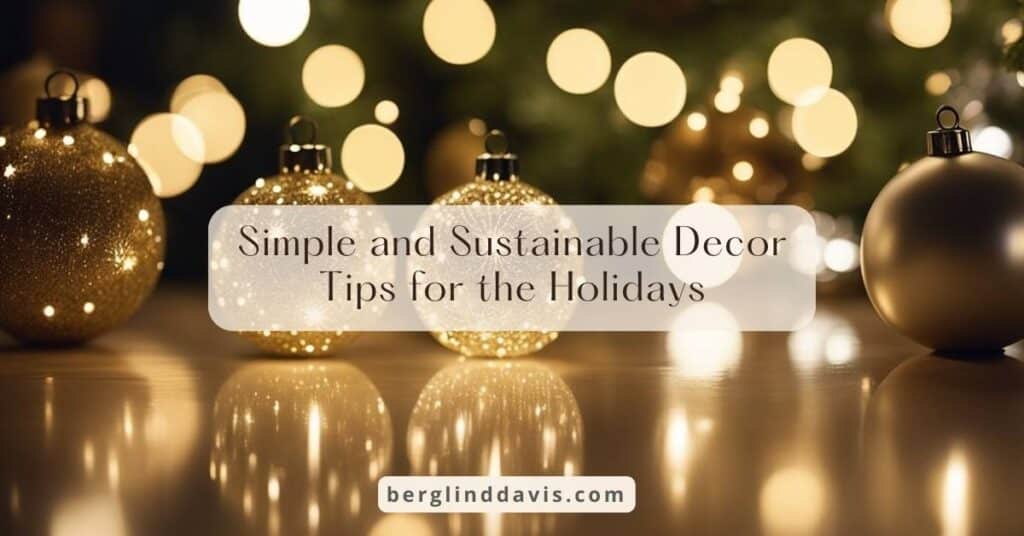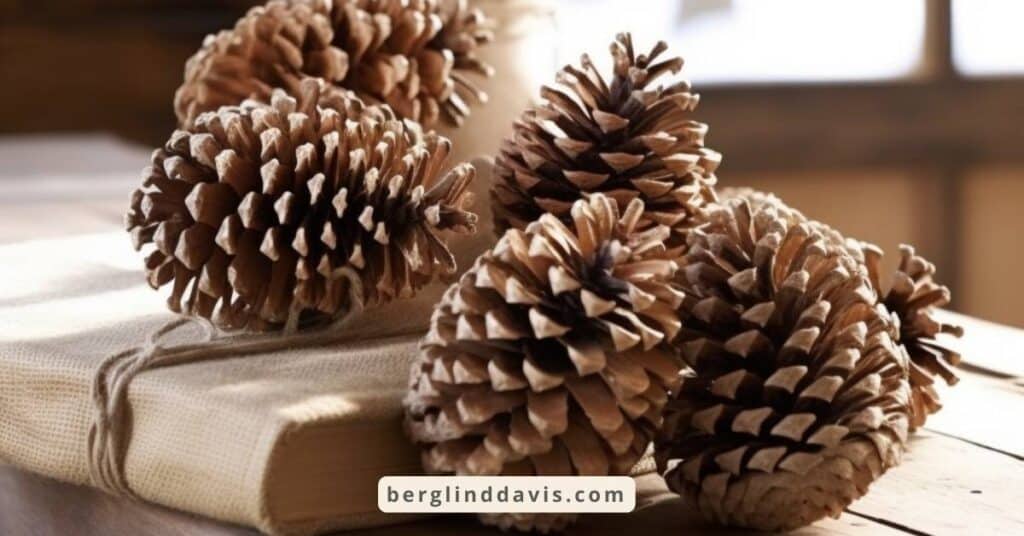Most Sustainable Holiday Decorations: Eco-Friendly Ideas for a Festive and Environmentally Conscious Christmas Season
The holiday season is the most wonderful time of the year, but it can also be the most wasteful. From food to household waste, the impact of the holiday season on the environment is significant. However, there are many ways to celebrate the season sustainably. Simple changes to your holiday decorations can reduce your carbon footprint and positively impact the environment.

Switching to LED lights is one of the easiest ways to make your holiday decorations more sustainable. LED lights use up to 90% less energy than traditional incandescent lights and last up to 25 times longer.
You can also reduce your environmental impact by choosing eco-friendly decorations from natural elements like cinnamon sticks, pine cones, and citrus fruit. Flea markets and antique shops are great places to find unique and sustainable Christmas décor.
Using reusable advent calendars, wrapping paper, and sending e-cards instead of traditional Christmas cards can further reduce household waste.
If you prefer a real Christmas tree, make sure to recycle it properly after the holiday season. Many cities offer tree recycling programs that turn the trees into mulch or compost.
Alternatively, you can choose an eco-friendly Christmas tree made from recycled materials or invest in an artificial tree that can be used year after year.
By incorporating sustainable practices into your holiday celebrations, you can enjoy festive decorations while also reducing your environmental impact.
The Essence of the Holiday Season

The holiday season is the most wonderful time of the year. It is a time when you can feel the festive holiday spirit in the air. The holiday season is celebrated in many cultures and has a rich cultural and historical significance. In this section, we will explore the essence of the holiday season.
Most Wonderful Time of the Year
The holiday season is a time of joy, happiness, and cheer. It is when you can spend quality time with your loved ones and create memories that will last a lifetime. The holiday season is also when you can decorate your home with festive decorations and brighten your surroundings.
One of the most popular decorations during the holiday season is the Christmas tree. The Christmas tree tradition dates back to the Middle Ages and has been a part of English heritage for centuries.
The evergreen tree symbolizes everlasting life and was used by ancient Egyptians, Chinese culture, and Hebrews in their celebrations.
Another popular decoration during the holiday season is the Christmas wreath. The wreath is a circular decorative item made from natural elements like pine cones, cinnamon sticks, and citrus fruit. It symbolizes the holiday season and is often hung on doors or windows to welcome guests.
Cultural and Historical Significance
The holiday season has a rich cultural and historical significance. Christmas is celebrated on December 25th, a Christian holiday commemorating the birth of Jesus Christ. The holiday season also includes other celebrations like Yule and the winter solstice, which have pagan origins.
People come together to celebrate and share their joy during the holiday season. It is a time when you can give back to your community and help those in need. Sustainable practices like flea markets, fair trade, and recycling bins can be incorporated into your holiday celebrations to reduce your carbon footprint and household waste.
In conclusion, the holiday season is a time of joy, happiness, and cheer. It is when you can celebrate with your loved ones and create memories that will last a lifetime. By incorporating sustainable practices into your holiday celebrations, you can reduce your environmental impact and positively contribute to the world around you.
Frequently Asked Questions

What are the environmental benefits of using LED lights for holiday decorations?
LED lights are a more eco-friendly option for holiday decorations because they use less energy than traditional incandescent lights. This means they have a lower carbon footprint and can help reduce your energy bills. LED lights also last longer, which means you won't have to replace them as often. Additionally, LED lights do not contain hazardous materials like mercury, which makes them easier to dispose of.
How can we reduce our carbon footprint during the holiday season?
One way to reduce your carbon footprint during the holiday season is by using sustainable Christmas decorations. Opt for decorations made from natural materials like pine cones, cinnamon sticks, and citrus fruit. You can also reduce your energy consumption by turning LED lights off when not in use.
Another way to reduce your carbon footprint is to recycle wrapping paper and other household waste. Use your recycling bin and compost food waste to minimize your environmental impact.
What are some eco-friendly alternatives to traditional wrapping paper?
There are several eco-friendly alternatives to traditional wrapping paper, including using reusable gift bags, wrapping gifts in fabric, or recycled wrapping paper. You can also get creative and use old newspapers, magazines, or even children's artwork to wrap your gifts. Another option is to use natural materials like twine, ribbon, or pine cones to decorate your gifts.
How does the sustainability of artificial trees compare to real Christmas trees?
Artificial trees have a higher carbon footprint than real Christmas trees because they are made from non-renewable materials like plastic.
However, using an artificial tree for several years can be more sustainable than buying a real tree yearly. If you do opt for a real tree, consider renting one or buying from a local, sustainable source. Real trees are biodegradable and can be recycled or composted after the holiday season.
How can natural materials like cinnamon sticks and pine cones be used in festive decorations?
Natural materials like cinnamon sticks and pine cones can be used in various ways to create festive decorations. You can use them to make wreaths, garlands, or table centerpieces. You can also use them to add a pop of color and natural texture to your holiday décor.
Cinnamon sticks can be used to make scented ornaments or potpourri, while pine cones can be painted or glittered to add a festive touch.

What practices can minimize food and household waste during holiday festivities?
To minimize food waste during holiday festivities, plan your meals ahead of time and only buy what you need. Use leftovers to make new meals or freeze them for later. You can also compost food waste to reduce your environmental impact. Opt for reusable decorations like decorative items or advent calendars to minimize household waste.
Shop at flea markets or antique shops to find unique, sustainable Christmas décor. Consider buying fair trade products to support sustainable practices and reduce your carbon footprint.
Sustainable Holiday Decorations
The holiday season is the most wonderful time of the year but it can also be wasteful. From food waste to household waste, the holiday season can have a significant impact on the environment.
However, with a few eco-friendly ideas and sustainable practices, you can reduce your carbon footprint and enjoy festive decorations.

Eco-Friendly Christmas Tree
The Christmas tree is often the centerpiece of holiday decorations, but real trees can have a significant environmental impact. Real trees require energy to grow, transport, and dispose of, and they often end up in landfills.
Artificial trees are not much better, as they are typically made from non-recyclable materials and can take centuries to decompose. Instead, consider a modern Christmas tree made from natural elements such as wooden twigs, branches, or origami.
LED Lights and Energy Consumption
Holiday lights are a staple of Christmas decorations, but they can be a significant source of energy consumption. LED lights use up to 90% less energy than traditional incandescent bulbs and last up to 25 times longer.
You can also consider solar-powered lights that use renewable energy and do not require an electrical outlet. When decorating your home, use a timer to turn off the lights during the day and when you are not at home to save energy.
Natural Decor: Cinnamon Sticks and Pine Cones
Candles and garlands are a great way to add a festive touch to your home, but they can harm the environment. Instead, consider using natural elements such as cinnamon sticks and pine cones.
Cinnamon sticks can be used to create a warm and inviting scent, while pine cones can be used to create a rustic and natural look. You can also use natural materials to create decorative items such as wreaths and ornaments.
Holiday Wreaths and Garlands
Wreaths and garlands are a great way to add a pop of color and festive cheer to your home. However, they can be expensive and often made from non-recyclable materials. Instead, make your wreaths and garlands using natural materials such as twigs, branches, and citrus fruit. You can also find sustainable options at flea markets and antique shops.
Festive Decorations with a Sustainable Twist
Finally, consider adding a sustainable twist to your holiday decorations. For example, opt for recyclable or reusable options such as fabric or newspaper instead of traditional wrapping paper.
You can also send eco-friendly Christmas cards from recycled paper or fair trade materials. Regarding food waste, consider composting or donating excess food to local food banks.
In conclusion, there are many ways to decorate your home for the holiday season while reducing your carbon footprint. Using eco-friendly decorations, natural elements, and sustainable practices, you can enjoy the most wonderful time of the year without harming the environment.
Christmas Trees: Real vs Artificial
When it comes to holiday decorations, the Christmas tree is often the centerpiece of the festivities. However, choosing between a real tree and an artificial one can be a difficult decision. In this section, we will explore the pros and cons of both options and the environmental impact of each.
Environmental Impact of Real Trees
Real Christmas trees are a renewable resource, as they are grown specifically to be cut down and used as decorations. However, transporting real trees from the farm to the store and your home can contribute to their carbon footprint. On the other hand, real trees can be replanted and continue to grow, which makes them a sustainable choice.
Pros and Cons of Artificial Trees
Artificial Christmas trees are a popular choice for those who want a tree that can be reused year after year. However, these trees are typically made from non-renewable materials like plastic and metal, which can have a significant environmental impact. Additionally, the production and transportation of these trees also contribute to their carbon footprint.
One of the benefits of artificial trees is that they do not shed needles, which can be a hassle to clean up. They are also often pre-lit with LED lights, which can save energy and money in the long run. However, they lack the natural beauty and scent of real trees.
The decision between a real and artificial Christmas tree comes from personal preference and values. A real Christmas tree may be better if you prioritize sustainability and the environment. However, an artificial tree may be the way to go if you value convenience and reusability.
Gift-Giving and Packaging

The holiday season is the most wonderful time of the year, but it can also be the most wasteful. Between wrapping paper, packaging, and food waste, the carbon footprint of the holiday season can be significant. However, there are many eco-friendly ideas that you can implement to reduce your impact on the environment.
Wrapping Paper Choices
One of the easiest ways to reduce waste during the holiday season is to choose your wrapping paper carefully. Traditional wrapping paper is often not recyclable and ends up in the trash. Instead, consider using recyclable or compostable wrapping paper made from recycled materials. You can also use newspapers or even fabric to wrap your gifts.
Another option is to skip the wrapping paper and use a reusable decorative item, such as a festive box or bag. Not only is this more sustainable, but it also adds a pop of color to your gift.
Reusable Advent Calendars and Gift Wrap
Another way to reduce waste during the holiday season is to use reusable advent calendars and gift wraps. Instead of buying single-use advent calendars and gift wraps, consider investing in a reusable option that you can use year after year. This not only reduces waste but it also saves you money in the long run.
You can also get creative with your gift wrap using natural elements such as cinnamon sticks, pine cones, or citrus fruit. These items not only add a festive touch but they can also be composted after use.
You can reduce household waste, energy consumption, and overall environmental impact by implementing sustainable practices in your gift-giving and packaging. Consider shopping at flea markets or fair trade stores for unique and eco-friendly Christmas décor.
You can also opt for LED holiday lights instead of traditional lights to reduce energy consumption. Finally, be sure to recycle any packaging or wrapping paper in your recycling bin to reduce your impact on the environment further.
Reducing Waste During the Holidays
The holiday season is the most wonderful time of the year, but it can also be the most wasteful. From food waste to household waste, the holidays can have a significant impact on the planet. However, with a few sustainable practices, reducing your carbon footprint and minimizing waste during the holiday season is possible.
Food Waste Minimization
One of the biggest sources of waste during the holidays is food waste. According to Brightly.eco, during the holidays, the average person generates 6.25 pounds of garbage daily, which is 43.75 pounds each week. To reduce food waste, plan your meals carefully and only buy what you need. Consider composting food scraps, which can be used as fertilizer for your garden. You can also donate excess food to local food banks or shelters.
Recycling and Upcycling Decorations
Another way to reduce holiday waste is to recycle or upcycle your decorations. Instead of buying new decorations every year, consider using recycled materials or upcycling items you already have.
For example, you can use old Christmas cards to make new ones or turn old wrapping paper into festive garlands. You can also use natural elements like cinnamon sticks, pine cones, and citrus fruit to add color to your décor.
Regarding holiday lights, consider using LED lights, which are more energy-efficient than traditional ones. According to GreenCitizen, LED lights use up to 90% less energy than traditional lights and can last up to 25 times longer. You can also reduce energy consumption by using natural light during the day and turning off lights when unnecessary.
Consider shopping at flea markets or antique shops if you want new decorations. You can find unique and sustainable items that can be used for years. You can also look for fair trade decorations, which support sustainable practices and help reduce waste.
These sustainable practices can reduce waste and minimize your carbon footprint during the holiday season. Remember to recycle, upcycle, and compost as much as possible to keep waste out of the landfill.

Shopping for Decorations and Gifts
Regarding holiday decorations and gifts, there are many ways to make sustainable choices that reduce your carbon footprint. Here are some tips to help you shop for decorations and gifts in an eco-friendly way.
Flea Markets and Antique Shops
Flea markets and antique shops are great places to find unique, cost-effective decorations and gifts. By buying second-hand items, you reduce waste and contribute to sustainable practices. Look for items that can be repurposed or upcycled, such as old picture frames that can be turned into festive decorations.
Fair Trade and Eco-Friendly Ideas
Another way to shop sustainably is by choosing fair trade and eco-friendly products. Many companies offer holiday decorations and gifts from sustainable materials such as recycled plastic, organic cotton, and bamboo. These products have a lower environmental impact and support fair labor practices. Consider buying fair trade or eco-friendly Christmas cards, wrapping paper, and cinnamon sticks.
Regarding holiday lights, consider switching to LED bulbs, which are more energy-efficient and have a longer lifespan than traditional incandescent bulbs. LED lights are also available in various colors and styles, so you can still achieve that pop of color in your festive decorations.
If you prefer a real Christmas tree, look for local growers who use sustainable practices. Consider donating your tree to be recycled into mulch or compost after the holiday. Alternatively, you can opt for an artificial tree made from recycled materials that can be used year after year.
In addition to shopping sustainably, you can reduce your household waste by using a reusable advent calendar, incorporating natural elements like pine cones and citrus fruit into your decorations, and maximizing natural light. By making small changes in your holiday practices, you can greatly impact the environment and enjoy a sustainable holiday season.

As the holiday season approaches, it's important to remember the impact our festive traditions can have on the planet. We can create a more sustainable and eco-friendly holiday season by making small changes.
If you're looking for a more eco-friendly Christmas tree, consider getting a real tree that can be replanted or recycled after the holiday. Alternatively, you can invest in a high-quality artificial tree that can be reused for many years.
Opt for recycled or reusable wrapping paper when wrapping gifts, or get creative and use fabric, newspaper, or brown paper bags. You can also reduce food waste by planning your holiday meals carefully and composting any leftovers.
By incorporating sustainable practices into your holiday traditions, you can enjoy the most wonderful time of the year while also doing your part to protect the planet. Remember to recycle and use your recycling bin properly, and make eco-friendly choices whenever possible.






